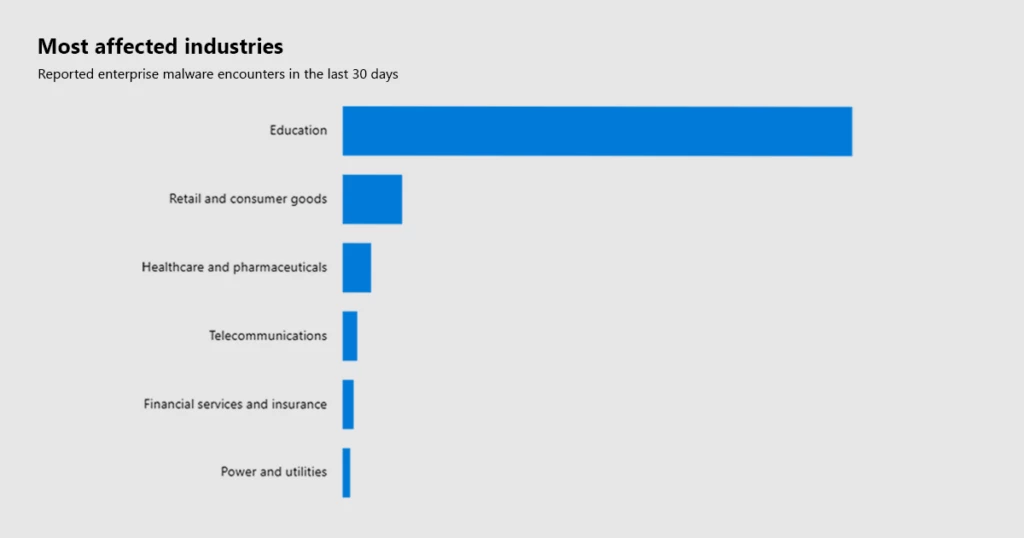
Addressing cybersecurity proactively to support hybrid learning
After detecting a potential cybersecurity threat, Fulton County Schools knew that it needed to investigate and come up with a diagnosis. Although its IT team found that the detected ransomware didn’t affect the school’s data, the district wanted to take a more proactive approach to cybersecurity moving forward.
Like many school districts, Fulton County Schools needed to bridge the gap between its legacy systems and a modernized cybersecurity posture. So, the school district launched a cyber-incident response plan, which includes using AI for predictive threat detection all day, every day. School leaders also organized a task force equipped with Microsoft Azure solutions that help monitor, detect, and stop threats. Now Fulton County Schools can detect cybersecurity threats before they occur and respond preemptively.
As more students have moved to hybrid learning, schools must learn how to mitigate ransomware, malware, and phishing attempts. From raising awareness to creating a response plan, there are many ways that institutions can reduce risk and make hybrid learning safe. By transforming their security stance with the latest cloud technologies, school districts can focus on what matters most: educating students.
Assessing the risks of hybrid learning
Each year, hundreds of K–12 schools experience cyberattacks. Criminals’ tactics have become more sophisticated, and cyberattacks are on the rise. As hybrid learning has become commonplace, educational institutions are now the number one target for malware attempts. Further, recovering from a single cybersecurity incident can be costly. Facing these factors, many schools are investing in cyber insurance for added protection.

Schools can better understand their level of risk by gauging their security stance using the Zero Trust Security Model Assessment Tool. They can also design a powerful defense strategy by staying aware of current cybercrime trends.
In the Microsoft Digital Defense Report 2022, Microsoft experts share their insights on the scale and scope of digital threats by analyzing 43 trillion data signals daily. Looking at the data, experts agree that organizations can ward off threats by addressing cybersecurity holistically. A holistic approach hinges on four concepts: identify, protect, detect, and respond. Even basic steps, such as setting up multifactor authentication, can drastically reduce an organization’s risk.
Global exam provider Pearson VUE is one of many institutions that has taken a holistic approach to cybersecurity. Every two seconds, the company delivers exams to test-takers across 20,000 test centers in more than 180 countries and territories. Upholding the integrity of its exams and protecting its data are key to the company’s mission.
Inspired by the Microsoft Zero Trust security framework, Pearson VUE migrated its on-premises networks to the cloud, helping it segment its networks. Now the company can enforce conditional access with users. Pearson VUE also began monitoring its environment using Microsoft Sentinel, which gives it the ability to capture enterprise-wide security analytics. Using AI technology, the exam provider gets automatic alerts of suspicious activity. These measures help Pearson VUE continue to maintain the integrity of its exams.
Staying ahead of the curve
Since the COVID-19 pandemic, educational institutions have had to pivot to hybrid learning using limited resources. Additionally, many students may not have a secure network at home for logging into their courses remotely. Despite these challenges, many schools see this shift in learning as an opportunity to transform their technology.
The University of Pittsburgh’s Department of Biomedical Informatics built a HIPAA-compliant data enclave in the cloud. Now the university can centralize data from its legacy systems and enable collaboration no matter where researchers are located. With a secure data hub enabling remote and hybrid work, researchers can speed up clinical insights by sharing data with other collaborators.
Similarly, the University of Texas at San Antonio (UTSA) wanted to increase collaboration among students and educators. So, the university began using Microsoft Office 365 A5 as its standard communication platform and to deliver free tools to students and faculty. By providing these tools across the board, students and faculty can focus on their courses.
UTSA also has gained visibility into the delivery and open rates of its campus-wide announcements. With this information, the university can find ways to better serve its students. UTSA also set up advanced analytics, which helps it detect phishing scams faster than before.
Accessing additional resources
As schools engage with their students online and in the classroom, they can learn more about the latest cybersecurity trends from Microsoft Event webinars.
To access more resources for educational institutions at all levels, check out the Microsoft K–12 education showcase and the Microsoft higher-education showcase.




